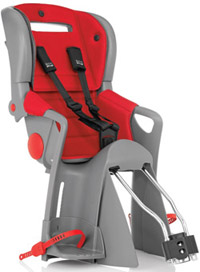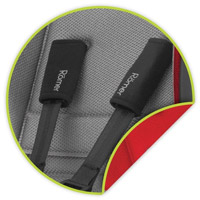Carrying Children on Bicycles

Choosing a seat
- Use one of the special child seats readily available from good cycle dealers and child-care shops. Look for one that conforms to BS EN 14344:2004, the British Standard for "Child Seats for Cycles".
- Seats which conform to BS EN 14344 are designed to carry children who are between 9 - 22 kg (roughly 9 months - 5 years of age) in weight or between 9 - 15 kg. Make sure your child is within the weight range of the seat you choose.
- Check that your child can sit comfortably in the seat.
- Check that the seat is suitable for use with your type of bicycle - ask the retailer.
- Most injuries suffered by children riding in child seats happen when the children's feet get caught in the spokes of the wheel. So never use a seat without footrests to act as a shield between the child's feet and the wheel.
- A harness is essential. Seats that conform to BS EN 14344 must have a good restraint system, with a child-proof quick release buckle, to hold your child in place.
- If the seat is designed to be mounted on a rear luggage carrier, make sure that the carrier can take the weight of the seat and child. It should conform to ISO 11243. Check that the seat's fixing brackets will fit the carrier. The more brackets, which fasten the seat to the bike, the better.
- Other good features are a high back, hand rests and wrap-around construction. As the cyclist, you may be glad of a fairly light-weight seat.
- Make sure the seat comes with good instructions about fitting and use.
- Seats which are fixed to the front of a bicycle and are attached to the handlebars reduce the bicycle's manoeuvrability and can affect steering and balance. The child (and sometimes the seat too) can also be flung forward when the rider brakes. If you use a seat that fits onto the front of your bike, make sure it does not attach in any way to the handlebars, and that it fits between the rider and the handlebars are better. Do not fit one in front of the handlebars.
Fitting a seat
- Be prepared to spend money on getting the seat fitted by a cycle dealer if you are at all unsure about how to do it yourself. Always ask for advice.
- If you fit the seat yourself, follow the instructions carefully and make sure all the brackets are tight.
- If the position of the seat is adjustable, position it so that it does not interfere with pedalling or steering. The further back a seat is, the more it will affect the handling of the bike.

Using a seat
- Children should not be carried unless they are within the weight range for the seat and they can sit up unaided for at least the length of the cycle journey. They should no longer be carried in the seat when they are above the maximum weight; in any case when they are about 4 - 5 years old they will probably complain about being cramped.
- Always use the harness. Children often fall asleep in cycle seats, and might slip out if unrestrained. If you have a spill, or just have to brake hard, the harness will act like a seat-belt to lessen the chance of the child being hurt.
- When you are not carrying a child, make sure that the loose harness cannot get caught in any moving parts.
- Always make sure your child wears a cycle helmet because small children's skulls are fragile, and it is good to get them into the habit of wearing a helmet as early as possible. Ensure that the child is warm and dry: it can be cold on a bike for a child, especially when they are not pedalling to keep warm!
- Practice riding off-road or on quiet roads first. It may take a while to get used to the effect the extra load has on handling, and the child may fidget. Getting on and off, signalling and cornering will all be a little more awkward, so you'll need to re-learn how to do these things without too much wobbling. A child is quite an extra weight, especially up hills, so take it easy and use the lower gears.
- Slow down gradually, well in advance of junctions. The extra weight means stopping takes longer, and harsh braking will give the child a rough ride.
- Make sure the child can't reach any moving parts, such as brakes, which might trap little fingers.
- The seat needs looking after. If you've been riding in the rain, dry it to reduce the risk of rusting.
- Every time you use the seat, check that the fastenings are sound and all nuts, screws and so on still tight.
Photos courtesy of Britax
